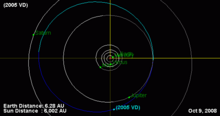| Discovery [1] | |
|---|---|
| Discovered by | Mount Lemmon Srvy. |
| Discovery site | Mount Lemmon Obs. |
| Discovery date | 1 November 2005 |
| Designations | |
| (434620) 2005 VD | |
| 2005 VD | |
|
centaur
[2]
[3] ·
damocloid
[4] unusual [5] [6] · distant [1] | |
| Orbital characteristics [2] | |
| Epoch 27 April 2019 ( JD 2458600.5) | |
| Uncertainty parameter 2 | |
| Observation arc | 11.40 yr (4,163 d) |
| Aphelion | 8.3535 AU |
| Perihelion | 4.9956 AU |
| 6.6746 AU | |
| Eccentricity | 0.2515 |
| 17.24 yr (6,298 d) | |
| 275.05 ° | |
| 0° 3m 25.92s / day | |
| Inclination | 172.87° |
| 173.31° | |
| 177.92° | |
| Jupiter MOID | 0.0306 AU |
| TJupiter | -1.3960 |
| Physical characteristics | |
Mean diameter | 6 km [4] |
| 0.04 (
assumed dark) 0.09 (assumed) [4] | |
| B–R = 1.05 [4] | |
| 14.3 [1] [2] | |
(434620) 2005 VD, provisional designation 2005 VD, is a centaur and damocloid on a retrograde orbit from the outer Solar System, known for having the second most highly inclined orbit of any small Solar System body, behind 2013 LA2. It was the most highly inclined known object between 2005 and 2013. The unusual object measures approximately 6 kilometers (3.7 miles) in diameter. [4]
Description
This minor planet was discovered on 1 November 2005, by astronomers of the Mount Lemmon Survey at Mount Lemmon Observatory near Tucson, Arizona. [1] Precovery images have been found by the Sloan Digital Sky Survey (SDSS) from September 2005 and December 2001.
Classification

2005 VD has a semi-major axis greater than Jupiter and almost crosses the orbit of Jupiter when near perihelion. JPL lists it as a current centaur. [2] Both the Deep Ecliptic Survey (DES), [3] and the Minor Planet Center (MPC) [7] have listed it as a centaur (qmin=~5AU) at different epochs. The DES and MPC will list as a centaur again in 2032.
Lowell Observatory also has it listed as a damocloid object. [6]
2005 VD makes occasional close approaches to Jupiter, coming only 0.0817 AU (12.22 million km) from Jupiter in 1903, 0.0445 AU (6.66 million km) in 2057, and 0.077 AU (11.5 million km) in 2093. However it made a close approach to Jupiter when it was only 0.309 AU (46.2 million km) away from it on 17 December 2022 which was the closest it could get to Jupiter for the decade. [2]
Dynamics
Being a highly dynamic object, even among centaurs, 2005 VD's orbit has visibly changed even since its discovery. Between 1600 and 2400, its semimajor axis will slowly increase from 6.64 to 6.96 AU, its eccentricity slowly increasing from 0.27 to 0.34, and a decreasing inclination from 176.7° to 169.9°. As such, until about 1870, 2005 VD was the most highly inclined known asteroid in the Solar System.
References
- ^ a b c d "434620 (2005 VD)". Minor Planet Center. Retrieved 17 January 2018.
- ^ a b c d e "JPL Small-Body Database Browser: 434620 (2005 VD)" (2022-11-19 last obs.). Jet Propulsion Laboratory. Retrieved 26 July 2023.
- ^ a b Marc W. Buie (28 August 2006). "Orbit Fit and Astrometric record for 05VD". SwRI (Space Science Department). Archived from the original on 12 December 2012. Retrieved 10 October 2008.
- ^ a b c d e Johnston, Wm. Robert (15 October 2017). "List of Known Trans-Neptunian Objects". Johnston's Archive. Retrieved 17 January 2018.
- ^ "List Of Other Unusual Objects". Minor Planet Center. 14 November 2018. Retrieved 20 November 2018.
- ^ a b Akimasa Nakamura (2 May 2009). "Table of Damocloid objects, or Oort cloud asteroids". Lowell Observatory. Retrieved 16 January 2018.
- ^ "List Of Centaurs and Scattered-Disk Objects". Minor Planet Center. Retrieved 16 January 2018.
External links
- (434620) 2005 VD, Small Bodies Data Ferret
- (434620) 2005 VD at AstDyS-2, Asteroids—Dynamic Site
- (434620) 2005 VD at the JPL Small-Body Database